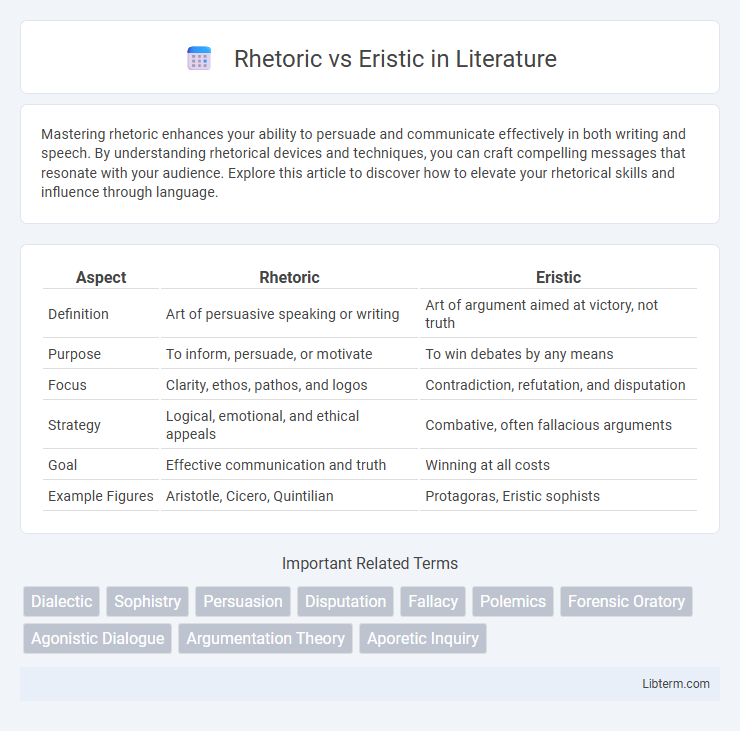Mastering rhetoric enhances your ability to persuade and communicate effectively in both writing and speech. By understanding rhetorical devices and techniques, you can craft compelling messages that resonate with your audience. Explore this article to discover how to elevate your rhetorical skills and influence through language.
Table of Comparison
| Aspect | Rhetoric | Eristic |
|---|---|---|
| Definition | Art of persuasive speaking or writing | Art of argument aimed at victory, not truth |
| Purpose | To inform, persuade, or motivate | To win debates by any means |
| Focus | Clarity, ethos, pathos, and logos | Contradiction, refutation, and disputation |
| Strategy | Logical, emotional, and ethical appeals | Combative, often fallacious arguments |
| Goal | Effective communication and truth | Winning at all costs |
| Example Figures | Aristotle, Cicero, Quintilian | Protagoras, Eristic sophists |
Understanding Rhetoric: Art of Persuasion
Rhetoric is the art of persuasion focused on constructing logical, emotional, and ethical appeals to influence an audience effectively. It employs strategies such as ethos, pathos, and logos to present arguments clearly and convincingly, fostering mutual understanding and agreement. Unlike eristic, which aims at winning arguments through contradiction and conflict, rhetoric seeks cooperation and truth through reasoned dialogue.
Defining Eristic: The Quest for Victory in Argument
Eristic centers on winning arguments through any means necessary, prioritizing debate tactics over truth-seeking, often employing fallacies and aggressive strategies to overpower opponents. Unlike rhetoric, which aims to persuade through clarity, logic, and ethical appeal, eristic thrives on conflict and controversy, valuing triumph in discourse above constructive dialogue. This approach prioritizes victory in argumentation, frequently sacrificing objectivity and mutual understanding.
Historical Origins: Rhetoric and Eristic in Ancient Greece
Rhetoric and eristic originated in Ancient Greece, with rhetoric emerging as the art of persuasive speech taught by figures like Aristotle and Isocrates to promote public discourse and civic engagement. Eristic, conversely, was focused on argumentative disputation aimed at winning debates regardless of truth, exemplified by the sophists such as Protagoras. These contrasting approaches shaped foundational principles in philosophy and education, influencing how dialogue and persuasion were perceived in classical antiquity.
Key Philosophers: Aristotle vs. the Sophists
Aristotle defined rhetoric as the art of persuasion based on logic, ethics, and emotional appeal, aimed at discovering truth and fostering constructive dialogue. In contrast, the Sophists practiced eristic, emphasizing argumentative skill for winning debates regardless of truth or moral considerations. This fundamental difference highlights Aristotle's commitment to reasoned discourse versus the Sophists' focus on competitive verbal combat.
Purpose and Intent: Persuasion vs. Winning
Rhetoric aims to persuade an audience through reasoned arguments and ethical appeals, fostering understanding and shared beliefs. Eristic focuses on winning debates by any means, often employing fallacies or aggressive tactics without regard for truth or consensus. The primary distinction lies in rhetoric's intent to build agreement versus eristic's goal of dominating the opponent regardless of validity.
Techniques and Strategies: Comparing Methods
Rhetoric employs persuasive techniques such as ethos, pathos, and logos to construct coherent arguments that appeal to the audience's values, emotions, and logic. Eristic focuses on argumentative strategies aimed at winning debates through refutation, contradiction, and often aggressive questioning rather than seeking truth. While rhetoric values clarity and emotional engagement, eristic prioritizes tactical maneuvers, including sophistry and logical fallacies, to dominate discussions.
Ethical Considerations in Rhetoric and Eristic
Rhetoric emphasizes ethical persuasion through clear, honest communication aimed at mutual understanding, respecting audience values and fostering constructive dialogue. Eristic prioritizes winning arguments by any means, often employing fallacies or manipulation, which raises ethical concerns about truthfulness and respect for interlocutors. Ethical considerations in rhetoric involve maintaining integrity and promoting truth, whereas eristic tactics risk undermining trust and intellectual honesty.
Real-World Applications: Education, Politics, and Law
Rhetoric plays a crucial role in education by fostering critical thinking and effective communication skills, empowering students to construct coherent arguments and engage in meaningful dialogue. In politics, rhetoric is employed to persuade constituents, shape public opinion, and advance policy agendas through ethical appeal and clarity. Conversely, eristic often appears in legal contexts during adversarial proceedings where disputation aims to win cases rather than seek truth, highlighting the importance of distinguishing constructive debate from mere contention.
Rhetoric and Eristic in Modern Discourse
Rhetoric in modern discourse emphasizes persuasive communication through clarity, ethos, pathos, and logos to foster understanding and cooperation. In contrast, eristic centers on argumentative disputation aimed at winning debates rather than seeking truth, often leading to polarization. The distinction highlights the importance of rhetoric in constructive dialogue and civil discourse today.
Cultivating Effective Communication: Choosing the Right Approach
Rhetoric emphasizes persuasive communication by appealing to logic, emotion, and credibility, fostering constructive dialogue and mutual understanding. Eristic centers on winning arguments through debate techniques, often prioritizing victory over truth, which can lead to conflict and misunderstanding. Choosing rhetoric cultivates effective communication by promoting clarity, respect, and genuine engagement, essential for meaningful conversations and collaboration.
Rhetoric Infographic

 libterm.com
libterm.com